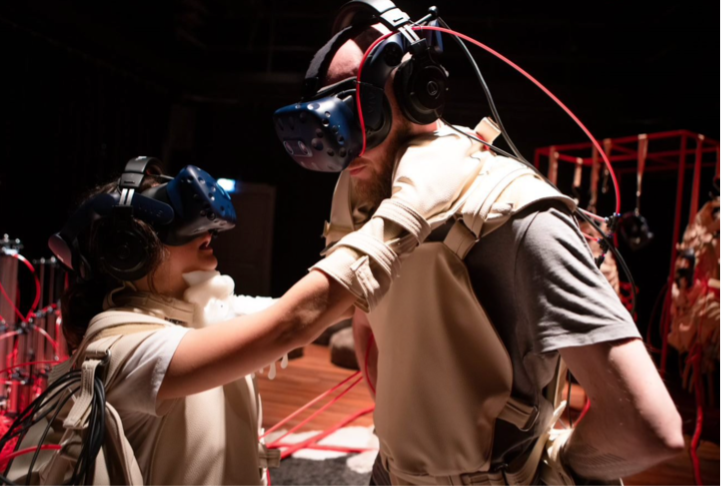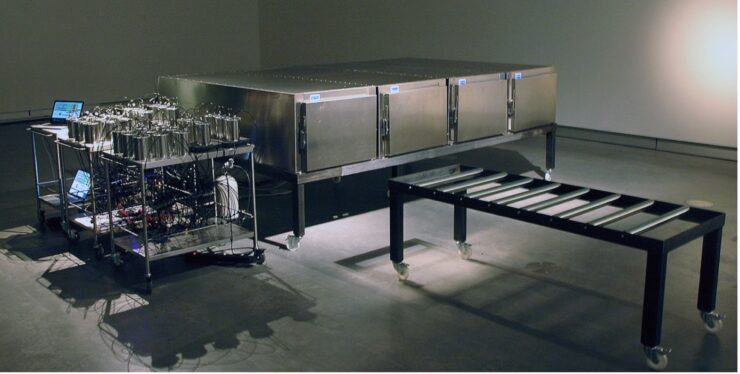Documentation
Imagining the power of a smelly robot – Elsbeth Hoefkens
A group of people dressed in beige costumes that distort them in many ways and make it almost impossible for them to move, share the same real but also virtual space. Immersed in the same virtual world, each participant has their own character and symbiotic role in the overall world and to each other. Depending on whether you are, say, a toad, a slime mold or a plant, you experience the world accordingly with all your senses.
It is 12 December 2022, and I am participating in one of Utrecht University’s Meet the Makers sessions. In this session, the interdisciplinary Dutch collective Polymorf, represented by co-founder Marcel van Brakel, has been invited to talk about their award-winning installation Symbiosis. Within their work, Polymorf focuses on creating multisensory experiences by using different media and new technologies. Symbiosis is one of those multisensory experiences, it’s a VR installation that involves a multi-user experience where, by redesigning the human body, a non-human reality is created for the participants. This non-human reality is evoked in addition to the VR world through the use of smell, taste and soft robots that move and inflate, giving your body a distortion. In creating this experience, Polymorf seeks to speculate on how a more symbiotic exchange between humans and other living beings can change the agency of all.
This session covered many of their different projects, all raising different thoughts and questions. They range from recreating someone’s last minutes before death (Famous Deaths) to a multimedia musical labyrinth called Zingmond that focused on parallel storytelling. Another theme that came up was the power and use of smell in, for example, cinema. When van Brakel described a machine that activates your appetite by diffusing scent, I started to wonder in what ways scent is already used within robots and what the possibilities of this might be.

Figure 1. Symbiosis, 2022. (Photo: Luciano Pinna)
From when I experienced Symbiosis myself, changing into the capacity of a slime mold, I especially remember how strongly the use of smell and taste influenced my experience and how I can still feel that reaction in my body when I think about it. Besides this powerful embodied experience, numerous studies have shown that the influence of scent on our perception is extremely strong, as scent is processed in our brain in the limbic system without being filtered first unless we are exposed to a smell for a long time and habituation occurs.[1] Therefore, scent has already been used in many ways and for many different purposes.

Figure 2. Symbiosis, 2022. (Design: Luciano Pinna, Frank Bosma and Wijnand van Tol
Within robotics, most use and research of smell is focused on giving robots t
he capability to smell. This research began in the 1980s and since, has been used, for example, to design robots that can recognise and locate the smell of drugs or missing humans. Or to create robots that can smell whether food is expired or even to detect cancer in a human body. Less research seems to be done regarding robots that use smell themselves. Besides the appetite-machine Van Brakel mentioned, I could only find some research about machines that use scent to make people calmer with the goal to let people fall asleep more easily.
Looking at the power of smell, this surprised me because, as Van Brakel described, smell has many functions within unconscious human communication that could be very interesting in research on social robots. For instance, some studies on human scents link different scents to different emotions.[2] Implementing this insight and therefore making robots smell in a certain way to express an emotion could perhaps improve human robot interactions. The problem, however, is that it is not yet clear exactly how these human scents work, which hinders their application in robots.
But perhaps that is (or should be) not the only “problem” with using scent within robotics and beyond. Scent is so powerful because it usually functions subconsciously, and scent is also very intimate because it is strongly connected to people’s memories.[3] Thus, we also need to be extremely careful with using it in immersive design and performances. Indeed, the fact that scent is already being commercialised in various ways to influence our consumption behaviour is still a fairly innocuous use of it.[4] After all, imagine how the use of smell can manipulate in much more and even less desirable ways with harmful goals such as the highly unconscious manipulation of emotions for political purposes.
Polymorph’s installation Famous Deaths in which the deaths of J.F.Kennedy, Whitney Houston, Lady Di, Moammar al-Qadhafi and Vincent van Gogh can be experienced, uses sounds and smells. Apart from the fact that the look of this installation already makes me shudder, critical questions can also be raised about the idea. Firstly, one can question whether recreating someone’s last minutes is ethical, despite the fact that these people were famous. Secondly, because the use of smell is mostly unconscious, it is difficult to predict what memories and emotions a smell might evoke in a participant. Combined with being in some kind of coffin and experiencing someone’s last minutes, I would argue that people can end up having a very unsafe experience as a participant without having estimated it that way beforehand. Finally, as innocuous as the purpose seems (entertaining people), I still find the application dubious because the use of scent is still very new which makes the projects that do use it exemplary. This is evidenced by the amount of global attention the installation received.[5] I therefore think it is important to apply this technique for inherently good purposes and not for recreating a death experience. But then, of course, the question arises as to what constitutes a “good” cause? And who then determines that? If you ask me, the application of smell should at least put a smile on people’s faces, just like the thought of a smelly robot.

Figure 3. Famous Deaths, 2014. (Photo: Polymorf)
[1] Sanem Bengü Uygunkan, “Olfactory Communication: Olfaction Process and Communication Relation” Online Journal of Communication and Media Technologies, Special Issue (December 2017): 48-50. https://www.ojcmt.net/download/olfactory-communication-olfaction-process-and-communication-relation.pdf
Rita Carter, The Human Brain Book: An Illustrated Guide to Its Structure, Function, and Disorders (London: DK Publishing, 2019), 96.
Sarah Wells, “Robots that can sniff out chemical weapons and pollution are coming soon – study” Inverse, May 11, 2020. https://www.inverse.com/innovation/sense-of-smell-robots
[2] Jasper H. B. de Groot, Gün R. Semin, and Monique A. M. Smeets. “On the Communicative Function of Body Odors: A Theoretical Integration and Review.” Perspectives on Psychological Science 12, no. 2 (March 2017): 306–324. https://journals-sagepub-com.proxy.library.uu.nl/doi/10.1177/1745691616676599
[3] Sanem Bengü Uygunkan, “Olfactory Communication: Olfaction Process and Communication Relation” Online Journal of Communication and Media Technologies, Special Issue (December 2017): 48. https://www.ojcmt.net/download/olfactory-communication-olfaction-process-and-communication-relation.pdf
[4] Kevin D. Bradford and Debra M. Desrochers, “The Use of Scents to Influence Consumers: The Sense of Using Scents to Make Cents” Journal of Business Ethics 90, no. 2 (2009): 141-143. https://www-jstor-org.proxy.library.uu.nl/stable/40665290#metadata_info_tab_contents
[5] Polymorf. “Polymorf interaction Famous Deaths” Collective Polymorf, n.d. https://www.polymorf.nl/interaction/famous-deaths/
Interesting sites/texts:
Sebag-Montefiore, Clarissa. “The movie you can smell” BBC, October 13, 2015. https://www.bbc.com/culture/article/20151013-the-movie-you-can-smell
Uygunkan, Sanem Bengü. “Olfactory Communication: Olfaction Process and Communication Relation” Online Journal of Communication and Media Technologies, Special Issue (December 2017): 47-56. https://www.ojcmt.net/download/olfactory-communication-olfaction-process-and-communication-relation.pdf
Wells, Sarah. “Robots that can sniff out chemical weapons and pollution are coming soon – study” Inverse, May 11, 2020. https://www.inverse.com/innovation/sense-of-smell-robots
The site of the collective and the installation:
Polymorf. “Polymorf about” Collective Polymorf, n.d. https://www.polymorf.nl/about/
Symbiosis. “Symbiosis show” Information installation Symbiosis, Polymorf, n.d. https://www.symbiosis.show
Bibliography
Bradford, Kevin D. and Debra M. Desrochers. “The Use of Scents to Influence Consumers: The Sense of Using Scents to Make Cents” Journal of Business Ethics 90, no. 2 (2009): 141-153. https://www-jstor-org.proxy.library.uu.nl/stable/40665290#metadata_info_tab_contents
Carter, Rita. The Human Brain Book: An Illustrated Guide to Its Structure, Function, and Disorders London: DK Publishing, 2019.
De Groot, Jasper H. B., Gün R. Semin, and Monique A. M. Smeets. “On the Communicative Function of Body Odors: A Theoretical Integration and Review.” Perspectives on Psychological Science 12, no. 2 (March 2017): 306–324. https://journals-sagepub-com.proxy.library.uu.nl/doi/10.1177/1745691616676599
Polymorf. “Polymorf about” Collective Polymorf, n.d. https://www.polymorf.nl/about/
Polymorf. “Polymorf interaction Famous Deaths” Collective Polymorf, n.d. https://www.polymorf.nl/interaction/famous-deaths/
Sebag-Montefiore, Clarissa. “The movie you can smell” BBC, October 13, 2015. https://www.bbc.com/culture/article/20151013-the-movie-you-can-smell
Symbiosis. “Symbiosis show” Information installation Symbiosis, Polymorf, n.d. https://www.symbiosis.show
Uygunkan, Sanem Bengü. “Olfactory Communication: Olfaction Process and Communication Relation” Online Journal of Communication and Media Technologies, Special Issue (December 2017): 47-56. https://www.ojcmt.net/download/olfactory-communication-olfaction-process-and-communication-relation.pdf
Wells, Sarah. “Robots that can sniff out chemical weapons and pollution are coming soon – study” Inverse, May 11, 2020. https://www.inverse.com/innovation/sense-of-smell-robots

